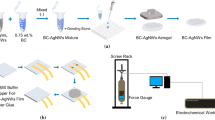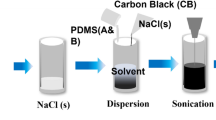Abstract
We report on a simple yet efficient approach to fabricate soft piezoresistive pressure sensors using copper nanowires-based aerogels. The sensors exhibit excellent sensitivity and durability and can be easily scalable to form large-area sensing matrix for pressure mapping. This opens a low-cost strategy to wearable biomedical sensors.





Similar content being viewed by others
References
Tien N, Jeon S, Kim D et al (2014) A flexible bimodal sensor array for simultaneous sensing of pressure and temperature. Adv Mater 26:796–804
Sekitani T, Someya T (2010) Stretchable, large-area organic electronics. Adv Mater 22:2228–2246
Wang C, Hwang D, Yu Z et al (2013) User-interactive electronic skin for instantaneous pressure visualization. Nat Mater 12:899–904
Park KI, Son JH, Hwang GT et al (2014) Nanogenerators: highly-efficient, flexible piezoelectric PZT thin film nanogenerator on plastic substrates. Adv Mater 26:2514–2520
Pan C, Dong L, Zhu G et al (2013) High-resolution electroluminescent imaging of pressure distribution using a piezoelectric nanowire LED array. Nat Photon 7:752–758
Fan FRR, Lin L, Zhu G et al (2012) Transparent triboelectric nanogenerators and self-powered pressure sensors based on micropatterned plastic films. Nano Lett 12:3109–3114
Kim DH, Lu NL, Ma R et al (2011) Epidermal electronics. Science 333:838–843
Gong S, Schwalb W, Wang Y et al (2014) A wearable and highly sensitive pressure sensor with ultrathin gold nanowires. Nat Commun 5:3132
Gong S, Lai DTH, Su B et al (2015) Highly stretchy black gold e-skin nanopatchs as highly sensitive wearable biomedical sensors. Adv Electron Mater 1:1400063
Gong S, Lai DTH, Wang Y et al (2015) Tatoo-like polyaniline microparticle-doped gold nanowire patches as highly durable wearable sensors. ACS Appl Mater Interfaces 7:19700–19708
Tang Y, Gong S, Chen Y et al (2014) Manufacturable conducting rubber ambers and stretchable conductors from copper nanowire aerogel monoliths. ACS Nano 8:5707–5714
Takei K, Takahashi T, Ho JC et al (2010) Nanowire active-matrix circuitry for low-voltage macroscale artificial skin. Nat Mater 9:821–826
Zhu B, Wang H, Liu Y et al (2016) Skin-inspired haptic memory arrays with an electrically reconfigurable architecture. Adv Mater 28:1559–1566
Wang Y, Gong S, Wang SJ et al (2016) Volume-invariant ionic liquid microbands as highly durable wearable biomedical sensors. Mater Horizon 3:208–213
Ma Z, Su B, Gong S et al (2016) Liquid-wetting-solid strategy to fabricate stretchable sensors for human–motion detection. ACS Sensor 1:303–311
Lipomi DJ, Vosgueritchian M, Tee BCK et al (2011) Skin-like pressure and strain sensors based on transparent elastic films of carbon nanotubes. Nat Nanotechnol 6:788–792
So HM, Sim JW, Kwon J et al (2013) Carbon nanotube based pressure sensor for flexible electronics. Mater Res Bull 48:5036–5039
Cohen DJ, Mitra D, Peterson K et al (2012) A highly elastic, capacitive strain gauge based on percolating nanotube networks. Nano Lett 12:1821–1825
Yao HB, Ge J, Wang CF et al (2013) A flexible and highly pressure-sensitive graphene–polyurethane sponge based on fractured microstructure design. Adv Mater 25:6692–6698
Smith AD, Niklaus F, Paussa A et al (2013) Electromechanical piezoresistive sensing in suspended graphene membranes. Nano Lett 13:3237–3242
Qiu L, Coskun MB, Tang Y et al (2016) Ultrafast dynamic piezoresistive response of graphene-based cellular elastomers. Adv Mater 28:194–200
Park M, Im J, Park JJ et al (2013) Micropatterned stretchable circuit and strain sensor fabricated by lithography on an electrospun nanofiber mat. ACS Appl Mater Interfaces 5:8766–8771
Gao Q, Meguro H, Okamoto S et al (2012) Flexible tactile sensor using the reversible deformation of poly(3-hexylthiophene) nanofiber assemblies. Langmuir 28:17593–17596
Ye S, Rathmell AR, Stewart IE et al (2014) A rapid synthesis of high aspect ratio copper nanowires for high-performance transparent conducting films. Chem Commun 50:2562
Rathmell AR, Wiley BJ (2011) The synthesis and coating of long, thin copper nanowires to make flexible, transparent conducting films on plastic substrates. Adv Mater 23:4798–4803
Bhanushali S, Ghosh P, Ganesh A et al (2015) 1D copper nanostructures: progress, challenges and opportunities. Small 11:1232–1252
Tang Y, Yeo KL, Chen Y et al (2013) Ultralow-density copper nanowire aerogel monoliths with tunable mechanical and electrical properties. J Mater Chem A 1:6723–6726
Jin M, He G, Zhang H et al (2011) Shape-controlled synthesis of copper nanocrystals in an aqueous solution with glucose as a reducing agent and hexadecylamine as a capping agent. Angew Chem Int Ed 50:10560–10564
Sachse C, Weiß N, Gaponik N et al (2014) ITO-free, small-molecule organic solar cells on spray-coated copper-nanowire-based transparent electrodes. Adv Energy Mater 4:1300737
Yang QQ, Liang JZ (2008) A percolation model for insulator–metal transition in polymer–conductor composites. Appl Phys Lett 93:131918
Bergma DJ, Stroud DG (1992) Physical properties of macroscopically inhomogeneous media. In: Mingzhong W, Hoffmann A (eds) Solid state physics. Elsevier, Amsterdam, pp 147–269
Clern JP, Giraud G, Laugier JM et al (1990) The electrical conductivity of binary disordered systems, percolation clusters, fractals and related models. Adv Phys 39:191–309
Schwartz G, Tee BCK, Mei J et al (2013) Flexible polymer transistors with high pressure sensitivity for application in electronic skin and health monitoring. Nat Commun 4:1859
Park S, Kim H, Vosgueritchian M et al (2014) Stretchable energy-harvesting tactile electronic skin capable of differentiating multiple mechanical stimuli modes. Adv Mater 26:7324–7332
Acknowledgments
This work was supported by ARC discovery Project (DP150103750). We also acknowledge Bin Su, Zheng Ma, Jiarong Li and Kean Aik Tan. This work was performed in part at the Melbourne Centre for Nanofabrication (MCN) in the Victorian Node of the Australian National Fabrication Facility (ANFF).
Author information
Authors and Affiliations
Corresponding author
Ethics declarations
Conflict of interest
The authors declare that they have no conflict of interest.
Electronic supplementary material
Below is the link to the electronic supplementary material.
About this article
Cite this article
Yap, L.W., Gong, S., Tang, Y. et al. Soft piezoresistive pressure sensing matrix from copper nanowires composite aerogel. Sci. Bull. 61, 1624–1630 (2016). https://doi.org/10.1007/s11434-016-1149-0
Received:
Revised:
Accepted:
Published:
Issue Date:
DOI: https://doi.org/10.1007/s11434-016-1149-0




